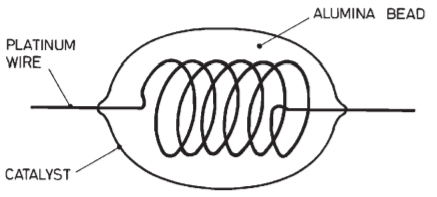Catalytic Pellistors
Catalytic pellistors solid-state devices used to detect gases which are either combustible or which have a significant difference in thermal conductivity to that of air. The detecting elements consists of small ‘’pellets’’ of catalyst-loaded ceramic whose resistance changes in the presence of the target gas hence the term ‘’pellistor’’ being a combination of ‘’pellet’’ and ‘’resistors’’.
To detect these gases types there are two types of pellistors; catalytic pellistors and thermal conductivity pellistors (TC), operating in different modes.
Catalytic Pellistors are gas sensors that detect combustible gases and vapours in air, in concentrations approaching the explosive range. In this case, they are operating in a catalytic mode where the target gas is burnt and the heat liberated is measured by the sensor.
Features
- Response to a wide range of combustible gases
- Simple circuitry
- A wide range of sensor types and operating voltages
- Poison and shock resistant versions available
Product range
AEP offers a wide range of pellistors. These can be supplied either as pellistor bead pairs (which are then placed in the your certified enclosure or within a certified enclosure. They can be either poison or non-poison resistant and may also be made to be sensitive to combustible gases, including or excluding methane.
Catalytic pellistors are available with a variety of working voltages and power levels. In general, the higher power devices are used in fixed systems and the lower versions in portable equipment. Low power pellistors are also available with the option of shock protection.
| Part Number | Description | Datasheet |
|---|---|---|
| VQ1B | Standard pellistor pair with high power and good stability | Download |
| VQ2B | Pellistor pair - Guaranteed performance with temperature and optimum stability | Download |
| VQ3BJ | Standard pellistor pair - high power, good stability | Download |
| VQ5MB | Thermal conductivity pellistor pair | Download |
| VQ21B | Poison resistant pellistor pair - general hydrocarbon sensing applications | Download |
| VQ22TB | Download | |
| VQ23TB | Pellistor pair | Download |
| VQ25B | Download | |
| VQ41TSB | Ammonia and high hydrocarbons pellistor pair | Download |
| VQ500 Series | Range of Catalytic and Thermal Conductivity Pellistor certified 4 series heads | Download |
| VQ547TS | Ammonia/high hydrocarbon certified head | Download |
| VQ548ZD | Certified Pellistor Head | Download |
| VQ549ZD | Certified Pellistor Head | Download |
| VQ547HT | NMP Catalytic Combustible Gas Sensor | |
| ECVQ-EK3 | Miniature catalytic and electrochemical gas sensor evaluation kit | Download |
Working of the Cataltic pellistors
The catalytic gas sensor consists of a coil of a small diameter platinum wire in a refractory bead. A layer of catalyst is deposited onto the bead. A current is passed through the coil heating up the catalytic material to approx. 500°C. At this temperature the catalytic material can burn the target gas producing heat. The resulting temperature rise is detected by the coil, in which the resistance rises. This active bead is known as the detector bead. In order to compensate for environmental factors such as temperature and pressure, the active bead is matched with inactive reference or compensator bead. This pair of beads is generally run in a simple wheatstone bridge circuit. The signal produced is proportional to the gas concentration up to the lower explosive limit, or LEL. The sensor will detect all combustible gases and vapours, although the response to higher hydrocarbons may not be high.
Applications
As these sensors measure gases in the 0 – 100% LEL range, they are routinely fitted in instruments used in applications where combustible gases could be present. The gas most often measured and encountered in the field is methane. This gas is present in coalmines, in places where organic matter is decomposing such as sewers, and as a major constituent in natural gas. There is also a sizeable market in measuring potential sources of methane in confined spaces associated with telecommunications. The majority of instrumentation is in the form of portable instruments many containing multiple gas sensors.
The main source of non-methane applications is monitoring of hydrocarbons, most commonly in the petrochemical industry both on and offshore and in monitoring for kerosene spillages. These instruments are generally calibrated for butane or pentane. In this case, as well as portable instruments, there is a significant market for fixed gas detection systems.
Applications for other gases also exist, e.g. for hydrogen in battery charging areas and ammonia in refrigeration plants.
Safety consideration
These gas sensors operate at temperatures above 400C and as such have the capability to ignite flammable gas mixtures. To prevent this, if the sensor is to be operated in an environment where combustible gases could be found, then it is necessary to enclose the pellistor beads in a certified flameproof head. This will allow the beads to be exposed to the target gas without the risk of ignition. AEP offers sensors both as beads and as beads within a certified head.
